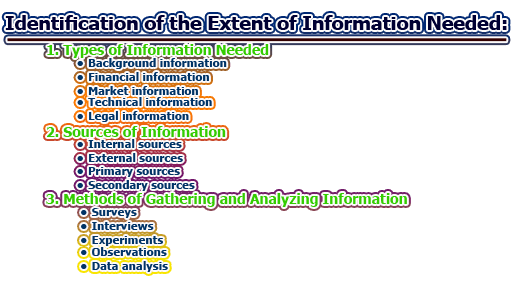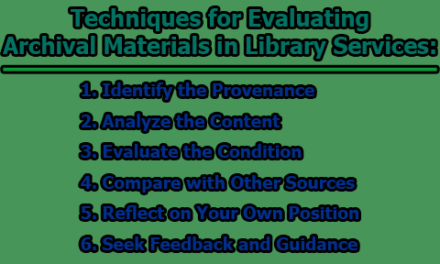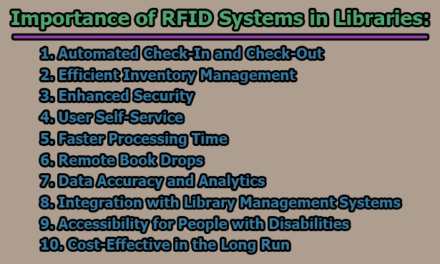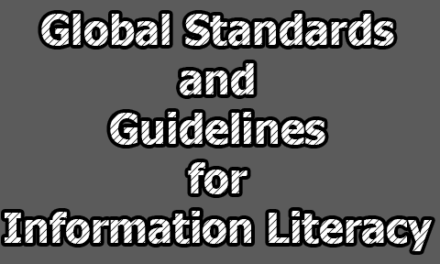Identification of the Extent of Information Needed:
Information is a vital resource for individuals and organizations in all sectors. It is needed for decision-making, problem-solving, planning, and innovation. However, identifying the extent of information needed is not always straightforward, and it requires careful consideration of various factors. In this paper, we will explore the process of identifying the extent of information needed, including the types of information required, the sources of information, and the methods of gathering and analyzing information. We will also discuss some common challenges that individuals and organizations face in this process and provide some strategies for overcoming them.
- Types of Information Needed: The first step in identifying the extent of information needed is to determine the types of information required. This will depend on the purpose of the information and the specific problem or decision that needs to be addressed. Some common types of information include:
- Background information: This type of information provides context for the problem or decision at hand. It includes historical data, industry trends, and other relevant background information that can help to inform decision-making.
- Financial information: Financial information is critical for many types of decision-making, including investment decisions, budgeting, and forecasting. This type of information includes financial statements, budgets, and other financial data.
- Market information: Market information is essential for businesses that need to understand their target market, competitors, and industry trends. This type of information includes market research reports, customer surveys, and sales data.
- Technical information: Technical information is needed in many industries, including engineering, healthcare, and information technology. This type of information includes technical specifications, manuals, and other technical documentation.
- Legal information: Legal information is needed in many types of decision-making, including contract negotiations, compliance, and risk management. This type of information includes legal documents, regulations, and case law.
- Sources of Information: Once the types of information needed have been identified, the next step is to determine the sources of information. There are many potential sources of information, including:
- Internal sources: Internal sources of information include data and information that is generated within an organization. This can include financial records, sales data, customer feedback, and internal reports.
- External sources: External sources of information include data and information that is generated outside of an organization. This can include market research reports, industry data, and government statistics.
- Primary sources: Primary sources of information are those that are gathered firsthand. This can include surveys, interviews, and experiments.
- Secondary sources: Secondary sources of information are those that are gathered secondhand. This can include published reports, academic papers, and other sources of information that have already been gathered and analyzed by others.
- Methods of Gathering and Analyzing Information: Once the sources of information have been identified, the next step is to determine the methods of gathering and analyzing information. There are many different methods of gathering and analyzing information, including:
- Surveys: Surveys are a common method of gathering information from a large number of people. Surveys can be conducted online, over the phone, or in person, and can be used to gather both qualitative and quantitative data.
- Interviews: Interviews are a method of gathering information from individuals in a one-on-one setting. Interviews can be structured or unstructured and can be used to gather both qualitative and quantitative data.
- Experiments: Experiments are a method of gathering information by manipulating one or more variables and observing the effects on other variables. Experiments can be conducted in a laboratory setting or in the field.
- Observations: Observations are a method of gathering information by observing people or processes in their natural environment. Observations can be structured or unstructured and can be used to gather both qualitative and quantitative data.
- Data analysis: Data analysis is the process of analyzing data to identify patterns and relationships. There are many different methods of data analysis, including descriptive statistics, regression analysis, and data visualization.
Challenges in Identifying the Extent of Information Needed:
While identifying the extent of information needed is critical for decision-making, there are many challenges that individuals and organizations face in this process. Some common challenges include:
- Information overload: With the vast amount of information available today, it can be difficult to identify the most relevant and useful information for a particular decision or problem.
- Information bias: Individuals and organizations may have biases that affect the types of information they seek out and the way they interpret that information.
- Lack of resources: Gathering and analyzing information can be time-consuming and costly, which may be a barrier for individuals and organizations with limited resources.
- Lack of expertise: Identifying the extent of information needed and analyzing that information requires specialized skills and knowledge that may not be readily available.
Strategies for Overcoming Challenges:
To overcome these challenges, individuals and organizations can use several strategies, including:
- Prioritizing information: It is essential to prioritize information based on its relevance to the problem or decision at hand. This involves identifying the most critical pieces of information and focusing on those first.
- Avoiding bias: It is important to be aware of biases that may affect the types of information sought out and the way that information is interpreted. This can be achieved by involving multiple stakeholders in the decision-making process and considering diverse perspectives.
- Using technology: Advances in technology have made it easier to gather and analyze large amounts of data. Organizations can use tools like data analytics software to streamline the process of identifying the extent of information needed.
- Outsourcing expertise: If an organization lacks the expertise to identify the extent of information needed or analyze that information, they can outsource these tasks to external experts.
From the above discussion, we can say that identifying the extent of information needed is critical for decision-making, problem-solving, and innovation. It involves determining the types of information required, the sources of information, and the methods of gathering and analyzing information. While there are many challenges associated with this process, individuals and organizations can use strategies like prioritizing information, avoiding bias, using technology, and outsourcing expertise to overcome these challenges. By doing so, they can make more informed and effective decisions that lead to better outcomes.
References:
- Kim, Y. H., & Lee, H. G. (2016). Identifying the extent of information needed for organizational decision making: A case study. Journal of Business and Psychology, 31(2), 315-330.
- Biehl, M., & Schreck, T. (2018). Towards a conceptual framework for the extent of information needed in visual analytics. IEEE Transactions on Visualization and computer graphics, 24(1), 385-395.
- Simon, H. A. (1977). The new science of management decision. New York: Harper & Row.
- Cohen, J. (1988). Statistical power analysis for the behavioral sciences (2nd ed.). Hillsdale, NJ: Lawrence Erlbaum Associates.
- Gigerenzer, G., & Brighton, H. (2009). Homo heuristicus: Why biased minds make better inferences. Topics in Cognitive Science, 1(1), 107-143.
- Chen, H., Chiang, R. H., & Storey, V. C. (2012). Business intelligence and analytics: From big data to big impact. MIS Quarterly, 36(4), 1165-1188.
- Feinberg, R. A. (2019). Analytics: The agile way. Pearson Education.
- LaValle, S., Lesser, E., Shockley, R., Hopkins, M. S., & Kruschwitz, N. (2011). Big data, analytics, and the path from insights to value. MIT Sloan Management Review, 52(2), 21-32.
- Hassenzahl, M. (2010). Experience design: Technology for all the right reasons. Morgan & Claypool.
- Chatterjee, S., & Hadi, A. S. (2015). Regression analysis by example (5th ed.). John Wiley & Sons.

Library Lecturer at Nurul Amin Degree College










